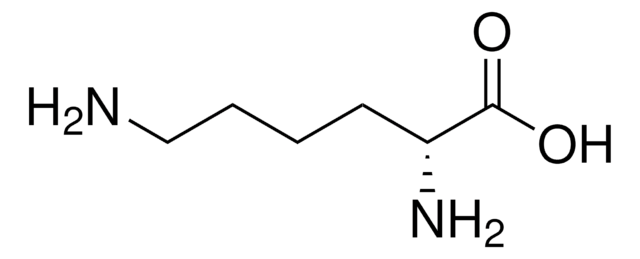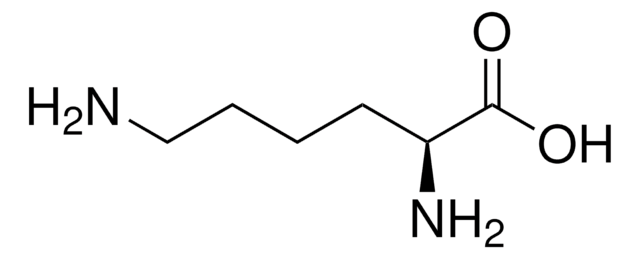L6001
DL-Lysine monohydrochloride
≥98% (HPLC)
Sinónimos:
DL-2,6-Diaminohexanoic acid monohydrochloride
About This Item
Productos recomendados
Nombre del producto
DL-Lysine monohydrochloride, ≥98% (HPLC)
Ensayo
≥98% (HPLC)
Formulario
powder
color
white to off-white
mp
267 °C (dec.) (lit.)
solubilidad
H2O: soluble
aplicaciones
peptide synthesis
cadena SMILES
Cl.NCCCCC(N)C(O)=O
InChI
1S/C6H14N2O2.ClH/c7-4-2-1-3-5(8)6(9)10;/h5H,1-4,7-8H2,(H,9,10);1H
Clave InChI
BVHLGVCQOALMSV-UHFFFAOYSA-N
¿Está buscando productos similares? Visita Guía de comparación de productos
Acciones bioquímicas o fisiológicas
Código de clase de almacenamiento
11 - Combustible Solids
Clase de riesgo para el agua (WGK)
WGK 3
Punto de inflamabilidad (°F)
Not applicable
Punto de inflamabilidad (°C)
Not applicable
Equipo de protección personal
dust mask type N95 (US), Eyeshields, Gloves
Elija entre una de las versiones más recientes:
¿Ya tiene este producto?
Encuentre la documentación para los productos que ha comprado recientemente en la Biblioteca de documentos.
Los clientes también vieron
Nuestro equipo de científicos tiene experiencia en todas las áreas de investigación: Ciencias de la vida, Ciencia de los materiales, Síntesis química, Cromatografía, Analítica y muchas otras.
Póngase en contacto con el Servicio técnico







